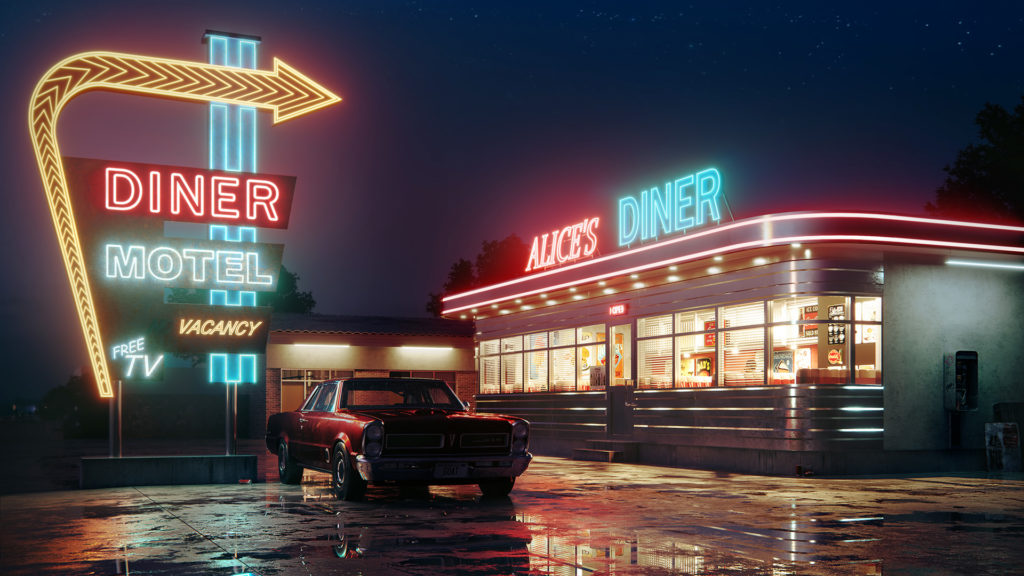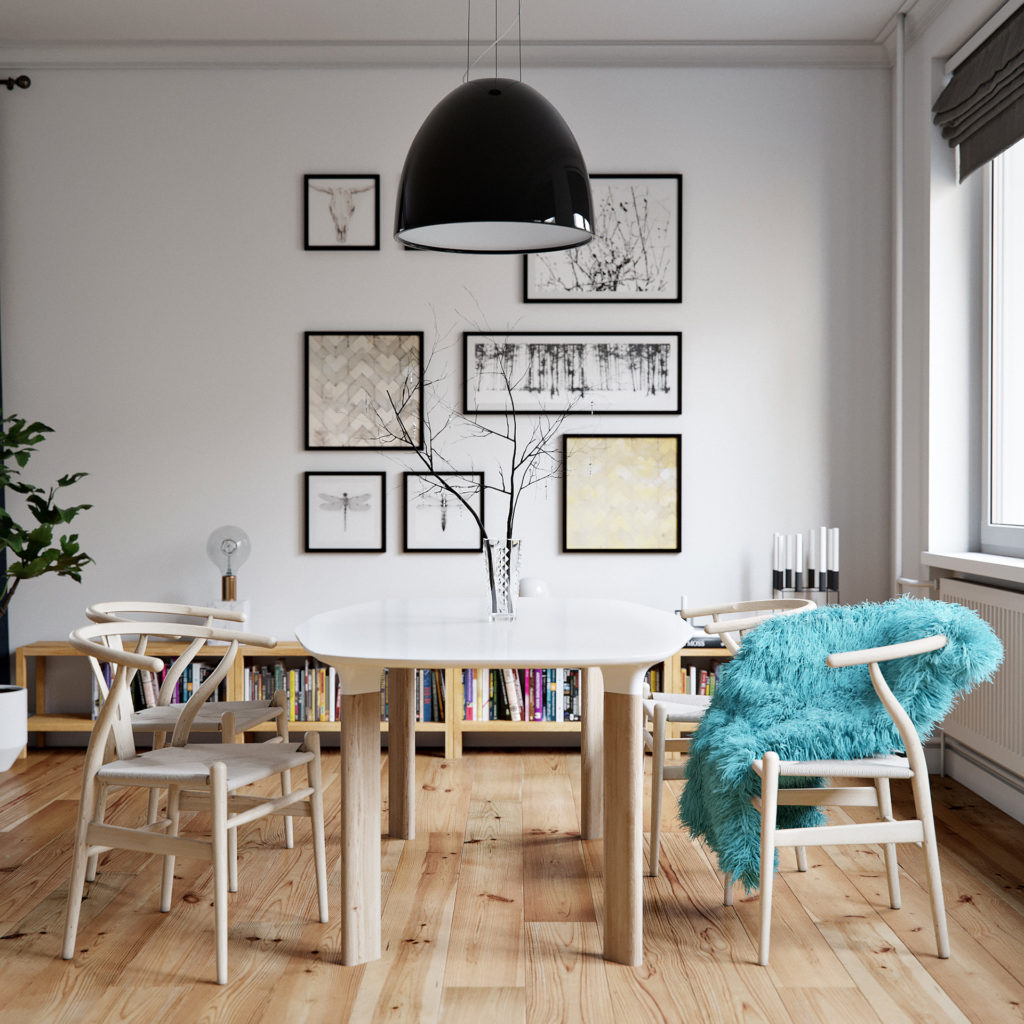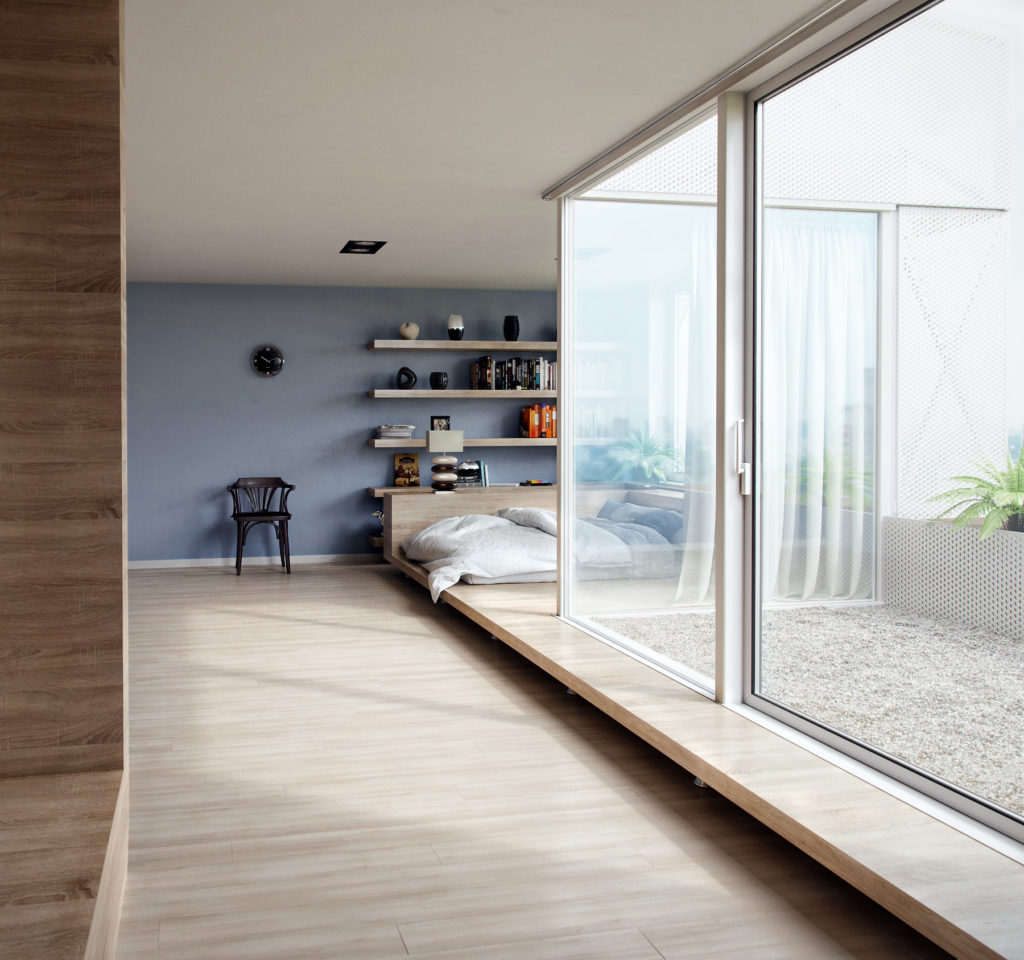Brief:
Area of living: Kharkiv, Ukraine
Working as: freelancer
Expertise: Interiors, Exteriors
You can find Aleksey:
– How did you eventually get into 3D visualization?
Initially, I came to this sphere when finishing my studies at the university, in the fifth year, while doing my master’s course.
– What was your major at the University?
Faculty of Computer sciences, specialization “Engineer-researcher of computer systems”. But in fact, we were taught how to do programming on C++, Java and web designing. I also got to know a little about 3D-graphics for six months. In fact, we studied all IT-disciplines, but introductory, and then we had to choose a specific area and devote the most of our time to it. Based on the area chosen we wrote term papers and diplomas. So it was in the fifth year when I got into computer graphics, 3D graphics. Actually, I originally liked to draw. The drawing was my hobby.
How did you turn to design from programming? It’s surprising because usually, programmers aren’t creative people, they are more of a mathematical mindset and, therefore, they do not know how to draw.
I initially thought to do programming for a living, but during my studying at the university I realized that I do not like programming that much. So I decided to follow a more creative route. I chose a certain sphere, tried working in it for some time and then came to a certain conclusion whether I liked it or not, whether I wanted to continue doing it 5-10-15 years of my life or not. At first, I thought about doing web design. I studied it for about six months and decided that this is not exactly what I need and continued searching. After that I tried my hand at in 2D graphics, I wanted to draw concepts. But at that time I was still studying at university, it was the beginning of my fourth year and I did not have a tablet. I did everything with the mouse so the week later my hand began to hurt. Then I decided that it didn’t suit me either, at least not until I bought myself a tablet. And then one day I was watching the YouTube lessons on concepts, and I noticed that some artists made 3D models of creatures and characters in Zbrush first. Then they took the early model into Photoshop and only there they did it over. Or did it in Zbrush completely, and after that in KeyShot, or in 3Dmax. I joined 3D graphics at the beginning of the fifth year. I had more spare time so I devoted it to understanding the 3D-graphics, while still finishing my studies and moonlighting at the same time. Then I studied Zbrush for 3-4 months. And my first projects for which I got paid were in Zbrush. I was doing the geometry, retopology, redrawing patterns where necessary.
– As far as I know, you do not have everything of that mentioned on the Behance…
I have a page on ArtStation, initially I posted it there. And I got acquainted with Behance when I began doing architectural visualization specifically.
– Then how did you get into architectural visualization?
I got there after finishing the fifth year of my master’s course. I wanted to gain experience of working in a studio, not just freelancing or part-time working, but real work.
– Did you manage to get there?
Yes, I did. After graduating from university, I moved to Kharkov and began to look for a job as a 3D specialist. But I started by drawing characters.
– For GameDev?
Yes, I made them for GameDev, made a robot for Plarium’s as part of the test task they gave me. Of course, it took me quite a while to do this task, but I was hoping I can get a job in the long run but failed. Also in Kharkov, there was a branch of Gameloft which is game development studio. They just called me for an interview without testing. I came, they questioned me about everything. But this was not a technical interview – the HR girl was just asking about personal qualities.
– Such interviews are certainly out of place.
Well, yes. You come to their office, and then one girl questions you, then a week later another girl does the same, then on the third time, you come in for an interview with some art director or with some other person responsible for the technical part. After that, I went to different studios for interviews. And then I was immediately called back by one studio. They were mainly engaged in architectural visualization. The studio was small – only 15 people worked there. And the bulk of their projects was on architectural visualization. But in addition, they did a little animation, a little mobile games, various assets, characters. When I came to them I was tasked with models for animation, because I already had some experience. And then they got more projects on architectural visualization so I started to get more tasks in that regard. Basically, it was draft work: to model, to draw the general plan…
– So you got the desired experience of working in a studio then why did you decide to become a freelancer, that is, leave the studio and work on your own?
Well, perhaps this is a feature of my character, but I don’t really like when I am supervised when someone stands behind my back, is wandering around me watching what I am doing at the computer.
– But Open Space is now practiced within modern companies. Large room, 100 people sitting without any walls…
There, in fact, was a large audience, too, that also didn’t have any walls. I have always managed to meet all the deadlines. But it also happened that you are sitting at work, checking YouTube, then Vkontakte for a while, and the chief spots it. And he immediately starts telling, “So, you are not working!”
– Do your clients ask you for which firms did you work?
Actually, they don’t ask, but I didn’t know about it back then. That is, I used to think that everyone does because it seemed to paint me in a very flattering light, how solid it was that you worked in the studio. But at that time I was also shaping my portfolio in evenings. And since the work was connected with the architectural visualization, I was slowly delving into this topic and decided to try myself purposefully in the architectural visualization. You can easier catch up with everything doing architectural visualization than character drawing. That is, in the architectural visualization you can easily understand it all.
– Wait, what is required for the character visualization? Why do you think a threshold of entry is higher there?
Let’s say, in the character visualization you need to have more artistic skills, such things like anatomy, how to properly configure skeletal animation.
– So architectural visualization is easier?
I cannot judge objectively what is simpler or what is more difficult. But at that very moment, I thought that in architectural visualization it was easier to reach a certain level to have some kind of stable income, stable freelancing projects. And so I gradually began to make a portfolio, began to look for clients.
– How were you (or are you) looking for clients?
At that time I was looking for them at freelance websites. Then I uploaded my portfolio on 3ddd, on vk, and then found Behance.
– Do customers find you on Behance?
Yes, they do. After I had posted a couple of my projects on Vkontakte, clients started writing me offering new projects. First, I worked with one guy, we did a couple of projects together. Then with another one. Then Artem Chuprinenko, the owner “Omega render”, wrote to me. We did one small project, both of us had nice experience so we began working more closely with each other. I added pictures to my portfolio on Behance, Vkontakte, 3ddd, and people began to write me themselves, offered cooperation or some projects. And I realized that there are more both profitable and solid projects than on freelancing sites. I started to get more and more tasks so I also taught my dad a couple of things. We took on projects together. He was mainly engaged in modeling, and I was more in customization: patterns, lighting.
– I see you have groups like CG Comrades on Behance. How did you get there?
Well, initially I met a guy, his name is Kostya and he is a designer, architect, and 3D specialist. He and I worked on a couple of projects. He made Vkontakte chat and invited a variety of artists there who have a good portfolio and good examples of work. And these artists then formed a group of CG Comrades and on Facebook, they made a group of Corona Renderer Russian – Russian group version of Corona Renderer.
– Do your clients find you through these groups?
No, not by using these groups. We have friendly relations there. We communicate, give some advice, ask each other.
– What are you better at – interiors or exteriors?
I think that would be interiors after all. I have done more interiors, I have a lot of experience and I mainly specialize in them.
– When you draw up interiors, do you come up with the design yourself or do you work with designers who tell you how and what to do?
It depends on the project. In some projects, I am already sent a specific design: furniture, materials, textures.
– Well, it is clear if you’re sent. And when not?
And when clients do not task me with anything like that, then, most often, the outcome is something like advertising images for catalogs. For example, people are building something and they need to just some beautiful and stylish design for their catalog, but not necessarily made strictly according to all the rules. They just need the picture look beautiful and stylish. Then I design it myself.
Here I am browsing Behance and I can’t help noticing that there are a lot of cool 3D specialists that make interiors. That is, these interiors are indistinguishable from photos and you can get confused when trying to make out what is it – a photo or 3D? But there are much less of those who make exteriors. So I want to ask you why you don’t like doing exteriors? Competition there is less than in the interiors.
I know that the competition is less there, but initially it happened because I did not have enough RAM on the computer. I mean, I lacked all of these scatters for green and grass to be beautifully spread. You could have simply scattered it. But to scatter beautifully you need several types of scatters, need mixing several types of grass, shades, small parts leaves…
– How do you talk to the customer? That is when a customer comes to you, what do you require from him? Do you have a specific plan or do you improvise every time with a new customer?
Firstly, there comes a request from the client, it is a standard one, in fact, “Here we have (or are planning) a project. Please tell me your price and timeframes.” It is clear that I cannot immediately name a specific price and terms, because it all depends on the project. That’s what I write to the client.
– Usually customers say, “Well, just tell me an approximate price.” What do you do in this case?
I just give them the average price and average timeframes, but clarifying, “This is average price or estimation”, etc.
– Don’t you rate your projects by the number of hours you are going to spend? Do you evaluate projects like you have 3 images it will be 3 thousand and here we go?
I do estimate by the number of hours, but I can’t immediately estimate exactly how much I will need. For example, I spend 11 hours on this. But since I have more than 3 years of experience, timeframes estimates are usually correct. To begin with, I need some sketch or plan at least, preferably with photos of furniture so only then I roughly estimate. If I see that there is some common furniture, for example, Poliform or Minotti, which can be found on 3dd somewhere, I understand that these models may not be counted. I look at whether there are unique models and roughly calculate how much time it will take me to model: half a day or the whole day, for instance.
– And depending on that you tell the customer how much will one picture cost?
Yes, depending on that. But I have a basic price, minimum for one render. Again, if multiple renders are required, the price is different.
– I: How many revisions do you allow clients to make?
Usually two of them.
– And if they want more?
If they initially ask for more I increase the amount of money paid.
– That means, at the beginning of the project you say, “I usually do two revisions. If you want a third and so on, you will have to pay extra”?
Yes. I usually write “State a cost. This cost includes two revisions.” If the client initially understands that two revisions will not be enough for him, he answers, “Can you make 5 revisions for us?” I say, “No problem, the cost of the project with five revisions will be this with the extra fee included”. If the client agrees to two revisions and then suddenly wants more revisions, more edits, then I write to him “I have sent the final pictures so unaccounted additional corrections will be considered as a separate work. The extra cost will be like this.”
– Have you ever given up a project?
I do not give up projects that I am currently working on, but I decline some proposals – yes, it is sometimes necessary to refuse.
– Why? Because of what?
Mainly because of busyness. Because I usually take projects for 1-2 months ahead. And customers often write, “Hello! We liked your works. We have a project, we need it to be ready in a week.” And then I have to say, “I have everything scheduled for a month ahead already, so I can’t take your project.”
– When you’re busy, don’t you hand these clients down to someone else? Don’t you say, “Go to them, they’ll do it because I’m busy right now”?
Yes, sometimes. I write to my colleagues, “Here is such a client, if you want, text him or I can send him your contacts”.
– With which client will you never work again? I mean, what does a “bad customer” look like?
One who stiffed, maybe.
– Well, that is clear. That means he did not pay the money. Are there any other criteria you can use to say, “I don’t want to work with you”?
I don’t like when they change or try to move timeframes and conditions in the process of working. We agreed with the client that it is necessary to finish the project, let’s say, on Friday. And so he tells me in the process, “I need it very urgently, urgently not on Friday, but on Wednesday.” If it’s the first time than it is okay. Sometimes I do not even ask for an additional fee if you need it faster, I simply prioritize this project, finish it faster and hand it over. But if it happens not for the first time, systematically, it is starting to trouble. Working alongside with several projects, I clearly plan my schedule, and sudden changes in timeframes lead to additional stress and long hours. I set deadlines, schedule beforehand, “Send me edits on that day”. And very often there are customers who do not send on this day, they keep silent for a week or two and then suddenly write, “Here we have edits, we need them to be done quickly” it is also additional stress, especially if you cannot strike a balance.
– You charge beforehand or upon finishing the project?
If a client is new I work with prepayment. And if it is a studio or a person with whom I work permanently, then I charge the money after the project. If I trust a customer then I do not take a prepayment.
– Is being a bad client the fault of the client himself or is it the performer’s inability, let’s say, a 3D-artist’s, to lead the project, to lead the client so that the client accepts the 3D-artist as a leader? And who’s to blame then?
It seems to me that both are to blame. Or let’s just say it’s mostly about a misunderstanding. Or I have missed the point when explaining something. I try to talk everything over at the beginning of the project. But if I did not do this in the beginning, then I try to endure the consequences somehow, let’s say, this is my fault.
– So, your verdict is that both are to blame?
Yes. I think most often the client’s fault is that he doesn’t understand that this is hard work. It’s not easy…
– That this is not just a picture, and it takes a week to do.
It is not about clicking on a mouse for half an hour to get everything ready. You have to sit all day and work constantly. However, some customers may understand it all, but they turn on the “fool mode”. And maybe they don’t understand and just think, “Yeah this is simple stuff, I email him now he will draw everything quickly and send back”. In this case, it’s the client’s fault, he does not fully value, does not understand the work of the 3D-specialist, the artist.
– Where do you get inspiration for your works?
Mostly from different sources. For example, from Pinterest. Especially for interiors it is mainly Pinterest, ArchDaily. Sometimes I get inspiration from different publics, to which I am subscribed, like Little Design on Vkontakte. Sometimes I wander through the feed and come across some cool interior! Or some cool exterior, some interesting works. I try to gain inspiration not from the renders, but from the photos. This is not my unique idea, I copied it from somewhere, heard it spoken about in some video tutorial or webinar… Well, I originally made the portfolio right from scratch. But when you’re a novice, you lack experience so it is unlikely you will come up with a unique design, make everything realistic. To make my portfolio I just found real photos first. Taking Poliform kitchen renderings from my portfolio – there are similar photos in Poliform catalogs. I just took pictures and modeled them, arranged the lighting. And in the following years, I also took pictures but tried to add something new or mix some elements.
– Can you rate yourself on a ten-point scale? How cool are you as a 3D specialist?
I don’t know… let it be 5-7 points.
– So you’re saying you don’t know half the things if you give yourself a five?
I don’t really know that many technical things. Maybe in terms of lighting, materials… I work in the “Omega render” team; I work with another studio and communicate with the guys, my colleagues. I understand that there are artists, and there are technicians among them. I think of myself more as an artist. And technically, I still can’t rate myself at 8 out of 10, or 9 out of 10.
– What do you think is the most difficult part of your job?
Probably the most difficult thing to correspond to the level stated in the portfolio for commercial projects, for different situations. Because there are different projects. And the timing differs.
– What do you like most about your work?
When I am working, I get carried away. When I was a child I enjoyed gluing tanks, I was fascinated by it. And now I’m fascinated by 3D. I mean, I can be sitting for half a day and without stopping to eat. You got up and just sit – and you are sitting, sitting, doing, doing. That’s probably why I work in this field.
– Where do you find the tutorials? How do increase your level? What helps you most?
I simply text what I need to find on YouTube and then watch. When you are just starting to learn, you open, and there’s an abundance of various tutorials…
– Well, I understand that whatever you discover is only appropriate for novices. And now that you have reached such a high level, how do you search for methods that can boost your level even more? Frankly speaking, all these tutorials on YouTube are more for beginners. What’s a tutorial for you?
Now I address YouTube only if I have some specific problem, some special task. For example, I need to do a kind of quilt in a Marvelous, and I don’t know how to carry it out. That is, I specifically search for such a video, watch and repeat it. But in general, I don’t watch any YouTube. I ask my colleagues, or they themselves share some of their lifehacks.
– Do you participate in 3D competitions?
No. There’s just not enough time.
– Do you have any personal ideas that you would like to implement, but you just do not have time? In 3D, I mean.
I had a few creative ideas, but I froze them, so to say. I started, brought them to some stage, then I was tasked with a bunch of projects, and the desire to make money prevailed. And I put off all such creative ideas. For instance, for a very long time, I have wanted to start doing something cool in terms of the exterior because I understand that I have a portfolio consisting mainly of interiors. That is, people see me as an interior designer and there are more and more interior designers every day. Maybe someday I will not have so many projects, so much work, so that I have the time to move on, to develop further. Exteriors are in the plans, besides in the future, perhaps VFX and movies, film industry, and everything else. But they are only plans.
You’ve never been on an enthusiastic team, have you? It’s when people get together and try doing something, not commercial, but to present the result so that other people could admire it, “Wow, how cool!”
I often saw such matters when I was only starting. Like we need to open a company, let’s do a couple of projects, and then the money would flow in and we will pay you back. In the very beginning of my career, I tried to get involved in doing something like this but did not manage to finish it, other members did not finish their parts either and we couldn’t make anything beneficial out of that.
– Well, you say you’re good at interiors now. For example, if you found some enthusiasts who can do cool exteriors and make something together, like animation. To show that this team made the animation. To get finer projects with those with whom you worked together, let’s say, for free. Didn’t you have such thoughts? Or haven’t you heard of anyone doing like this?
Not at all.
– I mean, it’s every man for himself? Nobody wants to share?
It’s not like every man for himself here. Everyone’s got a job to do. Other artists don’t have time to do it. When you are a beginner, you have lots of time, a few projects, so you spend on training. You did your first works and you are already receiving requests after them. You take projects, projects, and that’s all. It is where the working routine starts. There is still such a thing as seasonal works. And I noticed that I personally have more projects in spring and autumn. In the winter before the Catholic Christmas, there are lots of projects, deadlines, stress, and after Christmas and January – only a few projects, everybody is just refreshing after holidays. And from February we are up and running again. If you start doing something during this very period, you may have the needed energy to make a personal project. Take, my last works, for example, a multi-story cake, and some other…
– Well, this is a personal project, right?
Yes, truly personal. I was able to handle these personal projects in the following way: here I am surfing the web on Friday or Saturday and suddenly come across some photo. For example, I stumbled a picture of a cake. Well, not exactly like mine, but some other, also with candy, ice cream on top. And I immediately gain some inspiration: I desperately want to do something similar!
– No weekends then?
Yes, you’re working the whole weekend, upload it on Monday and continue working further. But this is probably what is called inspiration: one! Fired up by some idea so that and you do not want to take a walk, or go somewhere with your friends, or to play some games on the computer, instead, you are sitting and doing it until midnight. In the morning you get up, turn on the computer, again work until midnight or until the morning, until you finish, then post. My last personal projects were like this. And if you don’t get such inspiration, you will be just sitting and uploading nothing new.
– What are your plans for future career growth? I mean, do you want to start your own firm, or do you want to be alone?
Actually, yes. I have my own studio in the plans, and I am already working in that direction.
– Aleksey’s favorite 3D artists:
– Aleksey’s favorite 3d tutorial sources













